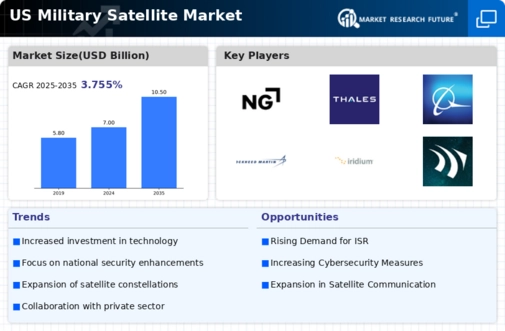Increased Defense Budgets
The military satellite market is benefiting from increased defense budgets across the US. As geopolitical tensions rise, the US government is allocating more resources to enhance its military capabilities, including satellite systems. The defense budget for 2025 is projected to exceed $XX billion, with a substantial portion earmarked for satellite technology development and procurement. This financial commitment indicates a robust growth trajectory for the military satellite market, as funding is essential for research, development, and deployment of advanced satellite systems.
Growing Demand for ISR Capabilities
Intelligence, Surveillance, and Reconnaissance (ISR) capabilities are critical for military operations, and the military satellite market is responding to this demand. The need for real-time intelligence has led to an increase in satellite launches dedicated to ISR functions. According to recent estimates, the ISR segment is expected to account for approximately XX% of the military satellite market by 2027. This growing emphasis on ISR capabilities is driven by the need for enhanced situational awareness and decision-making in complex operational environments, thus significantly impacting the military satellite market.
Strategic Partnerships and Alliances
Strategic partnerships and alliances are becoming increasingly prevalent in the military satellite market. Collaborations between government agencies and private sector companies are fostering innovation and accelerating the development of satellite technologies. These partnerships enable the sharing of resources and expertise, which is crucial for addressing complex military requirements. The military satellite market is likely to see a rise in joint ventures, with estimates suggesting that such collaborations could enhance market growth significantly over the next five years. This trend underscores the importance of cooperative efforts in advancing military satellite capabilities.
Focus on Cybersecurity in Satellite Operations
As military operations become more reliant on satellite systems, the focus on cybersecurity within the military satellite market is intensifying. The potential for cyber threats to disrupt satellite communications poses significant risks to national security. Consequently, the US military is prioritizing the development of robust cybersecurity measures to protect satellite operations. Investments in cybersecurity technologies are expected to grow, with projections indicating that this segment could represent a substantial portion of the military satellite market by 2028. This focus on cybersecurity is essential for ensuring the integrity and reliability of military satellite systems.
Technological Advancements in Satellite Systems
The market is experiencing a surge in technological advancements, which is driving demand for more sophisticated satellite systems. Innovations in miniaturization, propulsion, and communication technologies are enabling the development of smaller, more efficient satellites. These advancements allow for enhanced capabilities such as real-time data transmission and improved surveillance. The US military is increasingly investing in these technologies, with projections indicating that the market could reach $XX billion by 2030. This focus on cutting-edge technology is essential for maintaining a strategic advantage in modern warfare, thereby propelling growth in the military satellite market.




















Leave a Comment